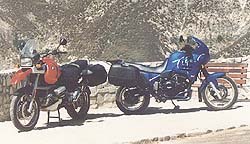Motorsports Racing News & Blog Articles
Church of MO: 1997 Adventure Tourers
It’s all the chattering classes can yak about now, but 25 years ago ADV was just getting off the ground! There were BMW GSs before it, but the grand dame R1100GS came around in 1994, and has been holding court ever since. Triumph’s Tiger was one of the first would-be usurpers: Will the new Tiger 1200 launching next month finally make the surp stick? Anyway, this 1997 Adventure Tourers test was a great MOment in time, especially from one Patrick Ciganer, Guest Commentator, at the end.
Seeking Adventure
Somewhere a motorcycle manufacturer’s marketing department coined the name “adventure tourers” to describe large-displacement dual sport bikes. Spawned from Paris-Dakar rally machines, they come equipped with hard luggage, enormous fuel tanks, high-mileage radial tires, comfortable seats, long-travel suspension and lots of ground clearance. Want to take a trip to Alaska? Maybe head south through Mexico’s rugged terrain? These will be the machines of choice. But which of these heavyweights works best in this environment? That depends on which side of the equation you place the most emphasis — adventure, or touring. Follow along as we do a photo-comparison of these two adventure bikes. The results may be surprise you.BMW’s Telever front suspension gives a natural anti-dive effect under hard braking, something you can do with confidence on the R11GS because of its Brembo-equipped dual discs and four-piston calipers. The Tiger’s softly-sprung, long travel forks dived excessively under heavy braking during spirited riding, putting it at a distinct disadvantage while chasing the Beemer through the canyons.

Using the same fuel-injected, 4-valve boxer motor as the R1100R Roadster, the GS produces a claimed 80 hp, the same output claimed by Triumph for its DOHC, 4-valve triple. But the BMW is a heavy beast. Although providing the perfect marriage between mechanical innovation and computerized electronics, its three-way catalytic converters, electronic engine management system and ABS-controlled triple disc brake system extol a large weight penalty. BMW’s Teutonic twin outweighs the Tiger by almost 50 pounds — an important consideration when blasting down rock infested trails.Off-road, the GS’ wide bars offer more leverage during tricky uphill climbs than the Tiger’s narrower bars, but then again, the Beemer shouldn’t be climbing hills off-road. The narrow windscreen provided a surprising amount of wind protection during freeway travel. BMW’s Rider Information Display, a broad array of functions and warning lights that includes the ABS warning system, is the prominent feature on the GS’ simple instrument panel. The ABS system can be disarmed through an instrument panel-mounted switch, something you’ll want to remember if you venture off the pavement with the GS. Take it from us, anti-lock brakes make it difficult to control a motorcycle as large as the Beemer when traveling down a slick, off-camber cobby downhill.
Meanwhile, the Tiger’s cockpit features the standard array of gauges and lights, and even has a clock — a nice touch when out on tour. A major nitpick though, is the dark-tinted lens cover over the idiot light strip that makes it hard to see the neutral light or turn signal indicators in daylight. More than once it caused us to travel down the highway for miles with a blinker flashing.
 |
 |
| Both the Triumph and BMW make excellent street machines. Their dual sport-inspired suspensions make traversing pot-holed infested pavement a piece of cake. You’d be surprised at how many sport bikes you can humble on one of these motorcycles. | Give the edge in sport riding to the BMW. |
 |
 |
| With its wider wheels and Metzeler tires, the BMW holds an advantage in the twisties over the Triumph and its less sport-oriented Michelins. | The GS puts out boatloads of low rpm torque, while the Tiger’s power is found higher in the rev band. |
 |
 |
| This is a typical view of the R1100GS off-road — sideways. The Beemer’s wider tires and wheels were of no extra help here. The bike’s suspension severely limited off-road fun. | The Tiger is a beautiful machine, turning heads everywhere we went. |
 |
 |
| BMW’s unusual styling cues with the GS elicited many unfavorable comments – you either love or hate it. | The Tiger’s GIVI luggage mounting system and hard saddlebags were the model of simplicity. Extremely easy to open, mount and remove, the bags had more carrying capacity than the GS’ but were no where near as stylish. |

Large dual-sport motorcycles are often categorized by the percentage of street-vs-off-road capability they possess. Make no mistake — both these bikes are happier on pavement than plowing through sand washes. 85 percent street, 15 percent dirt is the usual formula. And that 15 percent dirt had better be on smooth fire roads — there’ll be no rock-infested single-track trails in either of these bikes repertoires. Indeed, many adventure bike owners may never experience life beyond the asphalt, and the docile road-going manners of both the BMW-GS and Triumph Tiger make them perfectly suited for light-duty street-only touring.But if you seek real adventure and want your tourer to be capable of heading into the boonies when the need or desire arises, you’ll want the Tiger. Lighter weight, six-speed transmission, chain-drive, powerful high-rev motor, suspension that handles acceptably well in the street and even better off-road, there isn’t much that a Tiger rider would have to avoid. It’s only limitation is in its tires, which are not intended for serious off-road play — although the Triumph Tiger is willing in every other way.
The post Church of MO: 1997 Adventure Tourers appeared first on Motorcycle.com.
Copyright
© Motorcycle.com

